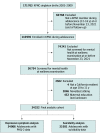Structural Racism and Adolescent Mental Health Disparities in Northern California
- PMID: 37594761
- PMCID: PMC10439477
- DOI: 10.1001/jamanetworkopen.2023.29825
Structural Racism and Adolescent Mental Health Disparities in Northern California
Abstract
Importance: Understanding how structural racism is associated with adolescent mental health is critical to advance health equity.
Objective: To assess associations between neighborhood privilege, measured by the Index of Concentration at the Extremes (ICE) and adolescent depressive symptoms, suicidality, and related racial and ethnic disparities.
Design, setting, and participants: This was a retrospective cohort study using electronic health records of adolescents aged 12 to 16 years who attended well-teen visits between 2017 and 2021. Kaiser Permanente Northern California is an integrated health care delivery system serving 4.6 million members. The cohort included 34 252 individuals born singleton at an affiliated facility from January 1, 2005, to December 31, 2009, and who had completed at least 1 mental health screener during a well-teen visit by November 23, 2021.
Exposures: American Community Survey 2016 to 2021 5-year estimates were used to calculate ICE scores for adolescents' residential census tract at ages 10 to 11. Three ICE measures were used as proxies of structural racism: racial privilege (ICE-race and ethnicity; hereinafter ICE-race), economic privilege (ICE-income), and combined economic and racial privilege (ICE-income plus race and ethnicity; herinafter ICE-income plus race). ICE scores were categorized into quintiles based on California statewide distributions.
Main outcomes and measures: Depressive symptoms and suicidality were assessed through self-report screeners during well-teen visits. Depressive symptoms were considered to be present if patients had a score on the Patient Health Questionnaire-2 of 3 or higher (the tool uses a Likert scale to determine the frequency [0 = not at all; 3 = nearly every day] that they had depressed mood and lack of pleasure in usual activities in the past 2 weeks; responses were summed and dichotomized).
Results: Analyses included 34 252 adolescents (12-16 years of age; mean [SD] age, 13.7 [0.8] years; 17 557 [51.3%] male, 7284 [21.3%] Asian or Pacific Islander, 2587 [7.6%] Black], 9061 [26.5%] Hispanic, 75 [0.2%] American Indian or Indigenous, 12 176 [35.5%] White, and 3069 [9%] other or unknown). Risks of depressive symptoms and suicidality generally increased with each level of declining neighborhood privilege. Adjusted risk ratios comparing adolescents from neighborhoods with the least to most racial and economic privilege were 1.37 (95% CI, 1.20-1.55) for depressive symptoms and 1.59 (95% CI, 1.23-2.05) for suicidality. Racial disparities between Black and White youth and Hispanic and White youth decreased after adjusting for each ICE measure, and became nonsignificant in models adjusting for ICE-race and ICE-income plus race.
Conclusions and relevance: In this cohort study, lower neighborhood privilege was associated with greater risks of adolescent depressive symptoms and suicidality. Furthermore, adjusting for neighborhood privilege reduced mental health disparities affecting Black and Hispanic adolescents. These findings suggest that efforts to promote equity in adolescent mental health should extend beyond the clinical setting and consider the inequitable neighborhood contexts that are shaped by structural racism.
Conflict of interest statement
Figures
Similar articles
-
Neighborhood Racial and Economic Privilege and Timing of Pubertal Onset in Girls.J Adolesc Health. 2023 Mar;72(3):419-427. doi: 10.1016/j.jadohealth.2022.10.013. Epub 2022 Dec 15. J Adolesc Health. 2023. PMID: 36528517 Free PMC article.
-
Neighborhood Privilege, Preterm Delivery, and Related Racial/Ethnic Disparities: An Intergenerational Application of the Index of Concentration at the Extremes.Am J Epidemiol. 2020 May 5;189(5):412-421. doi: 10.1093/aje/kwz279. Am J Epidemiol. 2020. PMID: 31909419
-
Using Index of Concentration at the Extremes as Indicators of Structural Racism to Evaluate the Association with Preterm Birth and Infant Mortality-California, 2011-2012.J Urban Health. 2019 Apr;96(2):159-170. doi: 10.1007/s11524-018-0272-4. J Urban Health. 2019. PMID: 29869317 Free PMC article.
-
Opportunities, challenges, and future directions for simulation modeling the effects of structural racism on cancer mortality in the United States: a scoping review.J Natl Cancer Inst Monogr. 2023 Nov 8;2023(62):231-245. doi: 10.1093/jncimonographs/lgad020. J Natl Cancer Inst Monogr. 2023. PMID: 37947336 Free PMC article.
-
Structural Racism, Workforce Diversity, and Mental Health Disparities: A Critical Review.J Racial Ethn Health Disparities. 2023 Aug;10(4):1985-1996. doi: 10.1007/s40615-022-01380-w. Epub 2022 Aug 5. J Racial Ethn Health Disparities. 2023. PMID: 35930174 Free PMC article. Review.
Cited by
-
Racial inequities and rare CFTR variants: Impact on cystic fibrosis diagnosis and treatment.J Clin Transl Endocrinol. 2024 Apr 20;36:100344. doi: 10.1016/j.jcte.2024.100344. eCollection 2024 Jun. J Clin Transl Endocrinol. 2024. PMID: 38765466 Free PMC article.
-
Linked emergence of racial disparities in mental health and epigenetic biological aging across childhood and adolescence.bioRxiv [Preprint]. 2024 Mar 28:2024.03.26.586786. doi: 10.1101/2024.03.26.586786. bioRxiv. 2024. Update in: Mol Psychiatry. 2025 Sep;30(9):4296-4306. doi: 10.1038/s41380-025-03010-3. PMID: 38586008 Free PMC article. Updated. Preprint.
-
A Standard Measure of Structural Racism, Do We Have One? Can We Have One? A Narrative Review of Commonly Used Measures and Domains of Use.J Racial Ethn Health Disparities. 2024 Sep 16. doi: 10.1007/s40615-024-02179-7. Online ahead of print. J Racial Ethn Health Disparities. 2024. PMID: 39285153 Review.
-
Latino adolescents' experiences of residential risks on social media and mental health implications.Sociol Health Illn. 2025 Feb;47(2):e13859. doi: 10.1111/1467-9566.13859. Epub 2024 Nov 2. Sociol Health Illn. 2025. PMID: 39487956 Free PMC article.
-
Harnessing Implementation Science in Clinical Psychology: Past, Present, and Future.Annu Rev Clin Psychol. 2025 May;21(1):529-555. doi: 10.1146/annurev-clinpsy-081423-021727. Epub 2025 Feb 19. Annu Rev Clin Psychol. 2025. PMID: 39971390 Free PMC article. Review.
References
-
- Office of the Surgeon General . Protecting Youth Mental Health: The US Surgeon General’s Advisory. US Department of Health and Human Services; 2021. - PubMed
-
- Merikangas KR, He JP, Burstein M, et al. . Lifetime prevalence of mental disorders in U.S. adolescents: results from the National Comorbidity Survey Replication—Adolescent Supplement (NCS-A). J Am Acad Child Adolesc Psychiatry. 2010;49(10):980-989. doi:10.1016/j.jaac.2010.05.017 - DOI - PMC - PubMed
MeSH terms
Grants and funding
LinkOut - more resources
Full Text Sources
Medical
Miscellaneous


